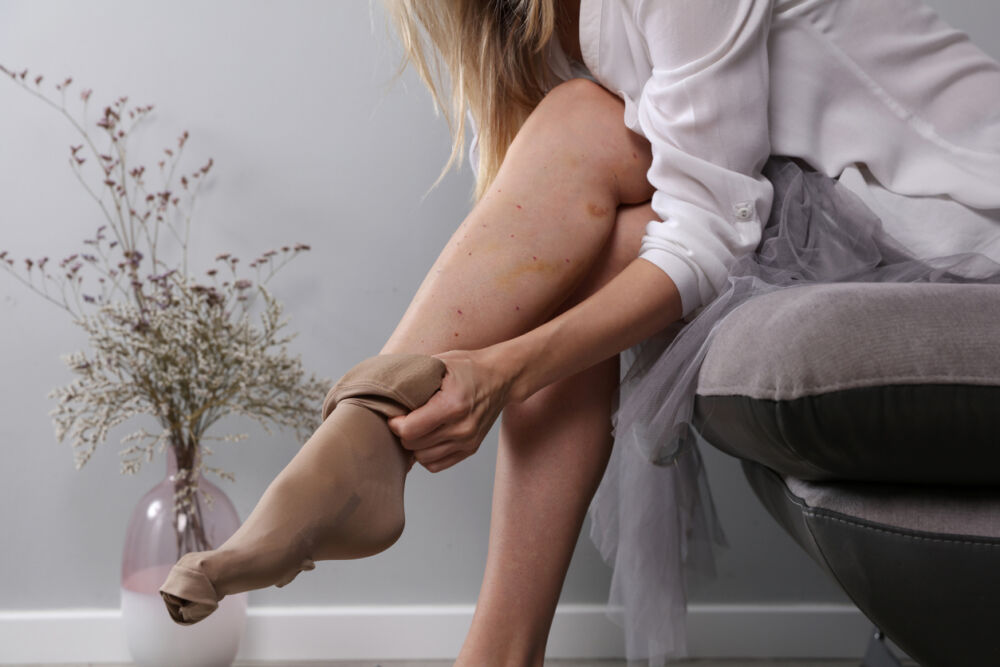
Working from Home? Consider Wearing Compression Socks.
Working from home for the first time due to the ongoing pandemic? Maybe it’s time to buy a pair of compression stockings.

The following is part one of a three-part series on using compression stockings to relieve leg discomfort written by venous and lymphatic disease expert Mohamed T. Hassan, MD, DABVLM, RPVI. Dr. Hassan is the lead physician at Center for Vein Restoration’s Hoover (Birmingham), Alabama, and Trussville, Alabama, vein clinic locations.
Center for Vein Restoration (CVR) is a leader in caring for people experiencing chronic venous insufficiency (CVI) symptoms. These warning signs range from leg pain and heaviness, itching, swelling, and restless legs, to leg wounds that don’t heal and ulcers. CVR has over 100 vein clinic locations in 22 states and Washington, DC.
Compression stockings can be a valuable tool for people suffering from varicose veins, deep vein thrombosis, or lymphedema. However, knowing how to apply them properly is essential to maximize their benefits. In this blog post, we will provide a step-by-step guide on how to apply compression stockings.
Step 1:
Choose the right compression stockings before applying compression stockings: Compression stockings are available in various sizes and compression levels, so selecting the one that fits you correctly is essential. You should consult your doctor or a professional fitter to determine which size and compression level are best for you.
Step 2:
Prepare your skin: Make sure your skin is clean and dry before applying the stockings. Avoid using creams, lotions, or oils, as they can make pulling the stockings on difficult and may interfere with the compression level.
Step 3:
Use rubber gloves when putting on stockings: Wearing rubber gloves can make it easier to grip the stockings and pull them up. This is especially true for people who have difficulty with grip strength or joint mobility.
Step 4:
Turn the stockings inside out: Start by turning the socks inside out, so the toe area faces you. This toe placement will make getting your foot into the stocking easier.
Step 5:
Place your foot into the stocking: Put your foot into the toe area of the stocking and gently pull the fabric up toward your ankle.
Step 6:
Pull the stocking up your leg with one hand: Grasp the top of the stocking and pull it up your leg, working in small sections. Use your other hand to smooth out the fabric as you go.
Step 7:
Smooth out the stocking: Once the stocking is on your foot, use your hands to smooth out any wrinkles or bunches in the fabric. You want the stocking to fit snugly—but not so tight that it causes discomfort or restricts blood flow.
Step 8:
Adjust the stocking: Once it is up to your knee or thigh, adjust it to sit comfortably on your leg. Make sure that it is not twisted or bunched up.
Step 9:
Repeat on the other leg: Repeat the process on your other leg, taking care to choose the correct size and compression level for that leg. Patients can be prescribed different levels of compression for each leg based on the pathology or the nature of the underlying problem, which can be more severe in one leg over the other.
Step 10:
Check the fit: After applying both stockings, check the fit to ensure that they are snug but not too tight. You should be able to move your toes and bend your knee without discomfort.
By following these steps, you will apply compression stockings correctly, thus helping to maximize their benefits and improve your quality of life. If you have any questions or concerns about compression stockings, consult your doctor or a professional fitter.
The time it takes for compression stockings to work can vary depending on the individual and the medical condition being treated. In general, you may begin to feel the benefits of compression stockings immediately after putting them on, such as reduced swelling and increased comfort.
However, it may take several days or weeks of regular use before you see significant improvement in your symptoms. For example, suppose you wear compression stockings to treat varicose veins or spider veins. In that case, it may take several weeks to see a noticeable reduction in their appearance.
If you are wearing compression stockings to prevent blood clots or other circulatory issues, it's essential to wear them as directed by your doctor. In some cases, you may need to wear them for several weeks or even months to achieve optimal results.
It's important to note that compression stockings are not a cure for medical conditions but rather a treatment option that can help manage symptoms and improve circulation. It's important to follow your doctor's instructions for wearing compression stockings and to maintain regular check-ups to monitor your condition and adjust your treatment plan as needed.
The benefits you can realize from wearing compression stockings hinge on getting the right fit and level of compression for you. The vein doctors at CVR are experts at using compression as an entirely non-invasive way to improve blood flow in your legs. Your CVR experience starts with a thorough evaluation of your vein health. Your CVR physician can then develop a customized treatment plan to put you on your way to looking and feeling your best!
Call 240-965-3915 to speak to a Patient Services Representative or book your appointment. You can also schedule online HERE.